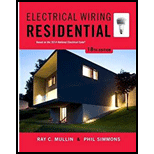
Concept explainers
In your own words, explain the terms alarm and detector.
_______________________________________________________________________
_______________________________________________________________________
_______________________________________________________________________
_______________________________________________________________________
_______________________________________________________________________
Explain in details about the terms “alarm” and “detector”.
Explanation of Solution
Discussion:
The device which provides a warning signal is known as an alarm and it works with the help of a detector when the minimum acceptable protection level is exceeded. An alarm plays a key role in the security systems of mines, residential buildings, and industries.
Example: Smoke alarms, Heat alarms, and Carbon monoxide alarms (alarms for explosive gases).
A detector is the device which has a sensor in the circuit. Sensor responds to the physical stimulus such as smoke, heat or some explosive gases.
Example: Smoke detectors, Heat detectors, and explosive gas detectors.
An alarm works with the co-ordination of a detector which has a pre-programmed sensor for the minimum acceptable levels of smoke, or heat, and so on, based on the application of an alarm.
Conclusion:
Thus, the terms “alarm” and “detector” are explained.
Want to see more full solutions like this?
Chapter 26 Solutions
Electrical Wiring: Residental - With Plans (Paperback) Package
Additional Engineering Textbook Solutions
Database Concepts (8th Edition)
Java: An Introduction to Problem Solving and Programming (8th Edition)
Web Development and Design Foundations with HTML5 (8th Edition)
Mechanics of Materials (10th Edition)
Automotive Technology: Principles, Diagnosis, And Service (6th Edition) (halderman Automotive Series)
Starting Out with Programming Logic and Design (5th Edition) (What's New in Computer Science)
- Q10 The full-load copper loss on the H.V. side of 100KVA, 11000/317 V, single-phase transformer is 0.62 kw and on the L.V. side is 0.48 kW. i) Calculate R1, R2 in ohms ii) Find X1,X2,if the percentage equivalent reactance is 4%, and reactance is divided in same proportion as resistance. Ans, 27.30, 0.175), 0.00482 . (7.5)arrow_forwardFind the binary sequence, for the following Differential Manchester code.arrow_forwardQ2- What are the parameters and loss that can be determined during open-circuit test of singlephase transformer. Draw the circuit diagram of open-circuit test and explain how can you calculate the Parameters and loss.arrow_forward
- Q6- the open circuit and short circuit tests on a 10 KVA, 125/250 v, 50 Hz single phase transformer gave the following results: O.C. Test: 125 V,0.6 A, 50 W ( on L.V.) S.C. Test: 20 V, 40 A, 177.78 W (on H.V. side) Calculate: i) Copper losses on half load ii) Full load efficiency at 0.8 leading p.f. iii) Half load efficiency at 0.8 leading p.f. iv) Regulation at full load at 0.9 leading p.f. Ans: 44.445 W, 97.23%, 97.69%, -1.8015%arrow_forwardQ3-A two-winding transformer has a primary winding with 208 turns and a secondary winding with 6 turns. The primary winding is connected to a 4160V system. What is the secondary voltage at no load? What is the current in the primary winding with a 50-amp load connected to the secondary winding? What is the apparent power flowing in the primary and secondary circuits? Ans. 120 V, 1.44 A, 6000 VAarrow_forwardQ12- A three phase transformer 3300/400 V,has D/Y connected and working on 50Hz. The line current on the primary side is 12A and secondary has a balanced load at 0.8 lagging p.f. Determine the i) Secondary phase voltage ii) Line current iii) Output power Ans. (230.95 V, 99.11 A, 54.94 kW)arrow_forward
- Q1- A single phase transformer consumes 2 A on no load at p.f. 0.208 lagging. The turns ratio is 2/1 (step down). If the loads on the secondary is 25 A at a p.f. 0.866 lagging. Find the primary current and power factor.arrow_forwardQ7- A 5 KVA, 500/250 V,50 Hz, single phase transformer gave the following reading: O.C. Test: 250 V,2 A, 50 W (H.V. side open) S.C. Test: 25 V10 A, 60 W (L.V. side shorted) Determine: i) The efficiency on full load, 0.8 lagging p.f. ii) The voltage regulation on full load, 0.8 leading p.f. iii) Draw the equivalent circuit referred to primary and insert all the values it.arrow_forwardQ4- A single phase transformer has 350 primary and secondary 1050 turns. The primary is connected to 400 V,50 Hz a.c. supply. If the net cross sectional area of core is 50 cm2, calculate i) The maximum value of the flux density in the core. ii) The induced e.m.f in the secondary winding. Ans: 1.029 T, 1200Varrow_forward
 EBK ELECTRICAL WIRING RESIDENTIALElectrical EngineeringISBN:9781337516549Author:SimmonsPublisher:CENGAGE LEARNING - CONSIGNMENT
EBK ELECTRICAL WIRING RESIDENTIALElectrical EngineeringISBN:9781337516549Author:SimmonsPublisher:CENGAGE LEARNING - CONSIGNMENT
